
Palm trees can be attractive and iconic elements in landscapes and gardens. However, there are several reasons why one might want to remove or kill a palm tree.
Maybe it’s their resemblance to Sideshow Bob…? But luckily, we’ve listed the best ways to remove your own real-life Sideshow Bob effectively, as well as easy-to-follow instructions.
1. Girdling
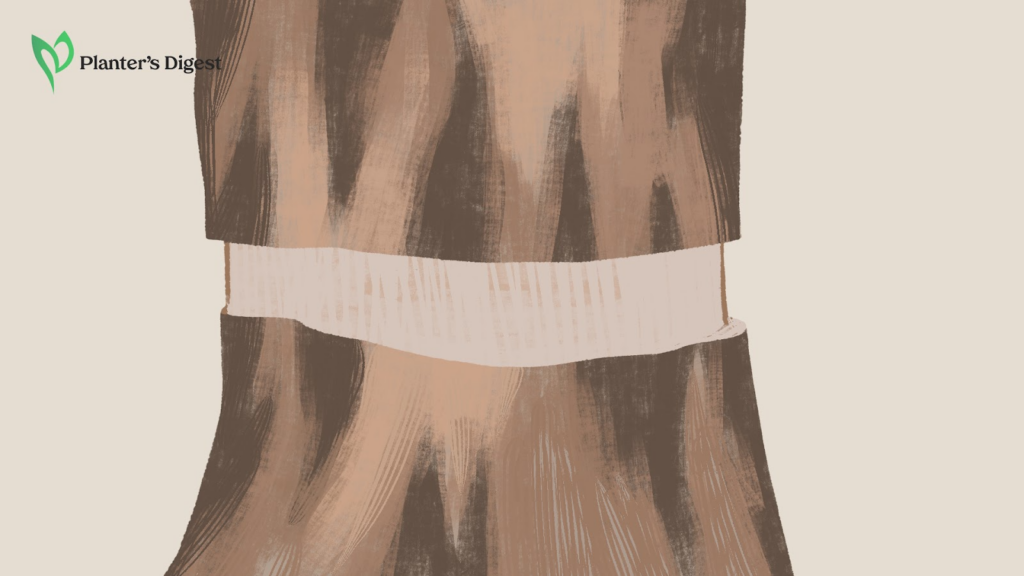
| Difficulty | Moderate ●●●○○ |
| Speed | Slow-acting to medium speed |
| Things You Need | • Personal protective equipment • Ladder, optional • Sharp knife |
Girdles can cut off fluid and oxygen circulation. Just ask anyone who’s tried corsets that have been laced too tight!
Girdling or ring barking requires homeowners to cut away a section of the bark around the trunk. When you girdle a palm tree, you cut a deep line all around the trunk.
This will stop the water and nutrients from going up to the leaves at the top. Eventually, girdling will cause the tree to die.
| How to Girdle a Palm Tree 1. Wear gloves and eye goggles. You want to take care of your eyes and hands! Plus, it doesn’t hurt if you wear other protective clothing to avoid accidents and sunburn. 2. Bring a ladder. Ladders help you get a leg up, especially if you need to cut the girdle at a high level. Make sure your ladder has all the safety features though. 3. Cut a line around the trunk of the palm tree. This will serve as your guide when you’re making the girdle. Remember to be careful when handling sharp tools. 4. Cut the line at least 1 to 2 inches wide and deep. Make sure that you can see the wood under the bark. Having a cut line that is wide and deep enough is sure to kill that unwanted palm tree. |
Important Notes
You’ll also need to check that the tree isn’t near anything dangerous to avoid hazards and accidents. Once the cut is complete, the palm tree will start to die.
Girdling can make a tree die, but it might not happen right away – it could take months or even years. While waiting for the tree to die, it’s important to keep an eye on it.
Also, girdling can have negative effects on the area around the tree. This is because dying trees tend to attract pests and may become a breeding ground for disease.
2. Salting

| Difficulty | Easy ●○○○○ |
| Speed | Slow-acting |
| Things You Need | • Personal protective equipment • Garden trowel • Watering can or garden spreader • Salt |
Salting is all about applying salt to the soil around the tree. The absorbed salt will dry out the roots, leading to the eventual death of the palm tree.
It doesn’t get simpler than that. The great thing about using this method is that it’s relatively cheaper unless salt in your area is sold at a high price.
| How to Salt a Palm Tree 1. Prepare at least one large salt bag or more as needed. The minimum amount you can do when salting is 3 pounds per 100 square feet. Of course, if you want a stronger dose then go right ahead! 2. Wear safety equipment. Just because it’s just salt doesn’t mean it’s harmless. Wear goggles, gloves, and other forms of protective clothing or equipment. 3. Get a watering can or garden spreader. They can be used to apply salt to the soil around the tree. Plus, it makes the application easier to control and more uniformly spread. 4. Dig a shallow trench around the base of the palm tree. The trench will house the salt that you’ll be applying. Make sure that it’s around 3 to 4 inches deep and 6 to 8 inches wide. 5. Pour a layer of salt into the trench. This is when your watering can or garden spreader comes in handy. Keep on pouring as long as you have salt with you. 6. Repeat the process as many times as necessary or preferred. To be honest, you can do it almost daily if you want. But you also have to know that it can go on for several weeks or months before you see any results. |
Important Notes
When the salt sinks into the soil, it will begin to dehydrate the roots. Dead and dry roots will prevent the tree from absorbing water and nutrients.
As time passes by, the tree will weaken and eventually die. During this time, you should monitor the tree as it dies because you definitely do not want it to be a safety hazard.
Dead and dying trees can also become a source of disease for other plants in the area. And if this happens, salting may cause more issues than it resolves.
On top of that, you should be careful when salting. Salt may seep into nearby water sources or damage other plants in the area.
3. Using Boiling Water

| Difficulty | Easy ●○○○○ |
| Speed | Slow-acting |
| Things You Need | • Personal protective equipment • Large pot or kettle • Watering can or bucket • Water |
Going with this method involves pouring hot water over the roots and around the base of the tree. This will damage the roots of the palm tree, leading to its death.
| How to Kill a Palm Tree with Boiling Water 1. Prepare a large pot or kettle to heat the water. The larger the container, the more water you can boil. But try to consider if you can lift and carry it, though. 2. Also, get some gloves, goggles, and a watering can or bucket. Prepare these items because they will help protect you from accidents. You want to keep your skin safe from burns. 3. Heat a large pot or kettle of water until it is boiling. Depending on how large your container is, this may take some time. We’d advise not to watch it until it’s boiling. You know what they say: a watched pot never boils! 4. Pour the hot water around the base of the palm tree. At this stage, the water will be hot, so watch yourself. If your gloves aren’t enough, then you might want to put on more hand protection. 5. Repeat the process as often as you like. Boiling water does tend to kill a lot of living things, including palm trees. In this case, it won’t be a one-time thing so you’ll need to repeat until the tree dies. |
Important Notes
Note that using boiling water may damage other plants in the area. Additionally, once boiling water gets into the ground, its temperature will lower and will not be as effective.
We think that while this is not the best method out there, it’s worth giving it a shot. Why not try it in conjunction with salt?
4. Cut Surface or Hack and Squirt
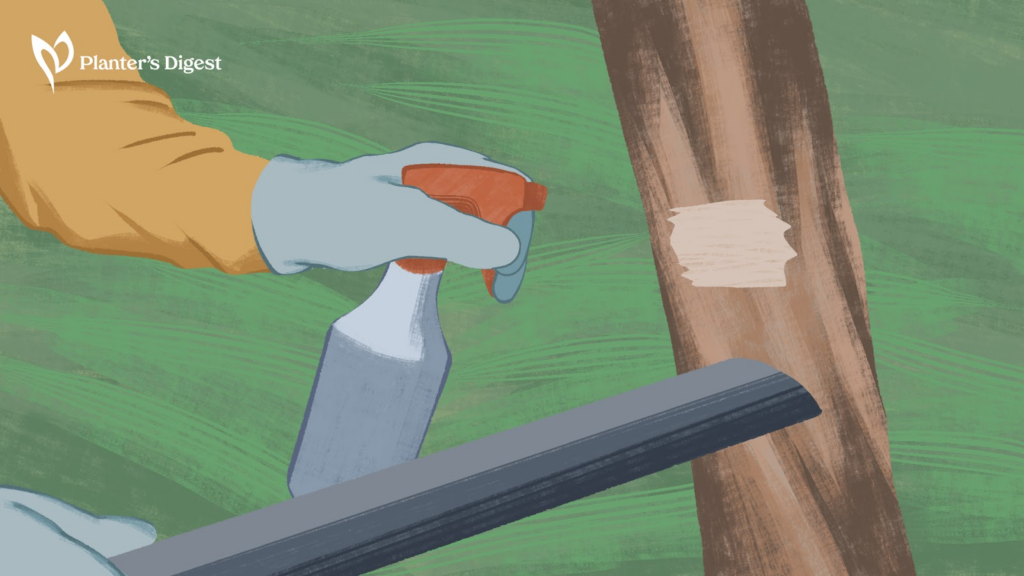
| Difficulty | Moderate ●●●○○ |
| Speed | Medium speed |
| Things You Need | • Personal protective equipment • Sharp saw or ax • Herbicide |
The hack and squirt method involves cutting a groove or notch into the trunk of the tree. After the groove has been made, a herbicide is applied directly to the wound.
The herbicide is then transported throughout the tree, killing it from the inside out. This method is commonly used to control invasive tree species and to remove unwanted trees.
| How to Kill a Palm Tree Using the Cut Surface or Hack and Squirt Method 1. Prepare a sharp saw or ax. The sharper your tool is, the better. We suggest sharpening it beforehand to make quick work of everything. 2. Buy the appropriate herbicide. It should ideally have triclopyr or picloram, as these chemicals target palm trees. Other chemicals may not be as effective, but you’re welcome to try them. 3. Bring out your protective gear and equipment. You’re going to be working with strong chemicals, so protect yourself at all costs. You want to kill the palm tree and not yourself, after all. 4. Make a series of shallow grooves or notches around the tree. Space the notches several inches apart and angled downward. This allows the herbicide to flow into the tree more easily. 5. Pour or spray the herbicide directly into the grooves or notches. Make sure you’re wearing protective gear at this point. Pour carefully so you don’t spill or expose yourself to the herbicide’s toxic chemicals. 6. Double-check the area to make sure there were no spills. Even a few drops can damage some plants. But if there aren’t, then you heave a sigh of relief behind the safety of your face mask or respirator. |
Important Notes
Over time, the herbicide will be transported throughout the tree, killing it from the inside out. Depending on the size and health of the tree, its death may take several weeks or months.
5. Basal Bark Treatment

| Difficulty | Moderate ●●●○○ |
| Speed | Medium speed |
| Things You Need | • Personal protective equipment • Backpack sprayer or hand-held spray bottle • Herbicide |
This method involves applying a herbicide mixture directly to the bark at the base of the tree. As a result, the herbicide is then absorbed into the tree’s circulatory system, causing it to die.
| How to Kill a Palm Tree Using the Basal Bark Treatment 1. Procure a container of herbicide. Make sure to get one that has triclopyr or picloram. These two chemicals are targeted to kill palm trees specifically. 2. Bring a backpack sprayer or a hand-held spray bottle. If you have more than one palm tree to kill, then a backpack sprayer is recommended. But if it’s just one small tree, a hand-held spray bottle works. 3. Wear your protective gear and equipment. The most important items are gloves, goggles, and a respirator. Trust us, you don’t want to inhale or get any toxic chemicals on your skin! 4. Mix the herbicide according to the instructions on the label. Manufacturers already know the correct ratio, so there’s no need to second-guess them. Plus, it makes things easier and simpler. 5. Apply the solution to the basal bark of the palm tree. Ideally, the height should be up to 12 to 15 inches above the ground. Keep it within this range and you should be good to go. 6. Coat the area entirely, covering the circumference of the tree. You should have enough herbicide solution to evenly coat the bark. If you have excess, then allow the herbicide to dry mid-way and reapply. |
Important Notes
The basal bark treatment method is most effective when performed during the dormant season. Typically, this is from fall to early spring when the tree is not actively growing.
It is important to note that this method should only be performed on woody species. For palm seedlings, herbicides that contain trifluralin or oryzalin should be used.
6. Injecting with Chemicals (Herbicide)
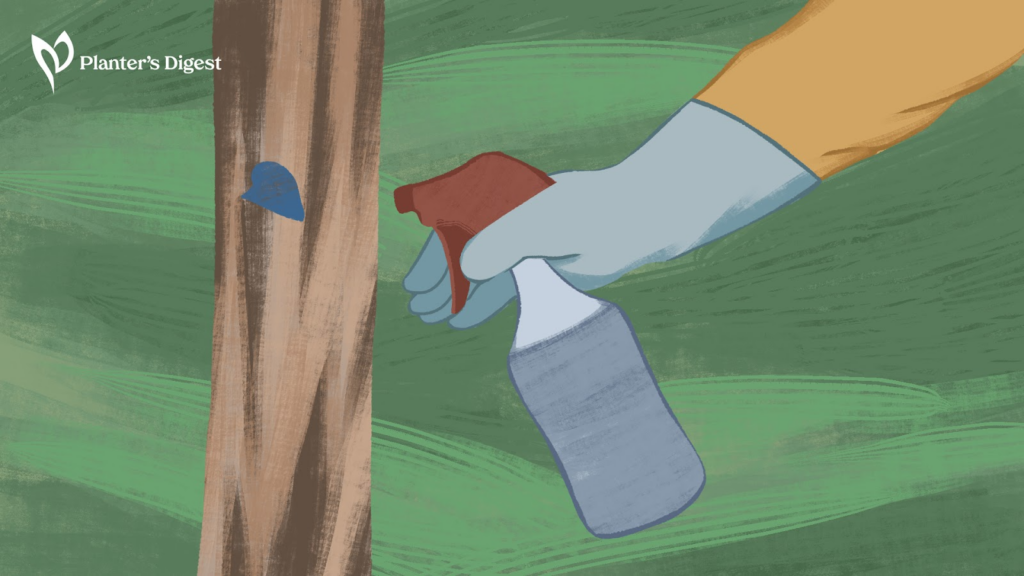
| Difficulty | Moderate ●●●○○ |
| Speed | Medium speed |
| Things You Need | • Personal protective equipment • Drill • Herbicide injection system or herbicide |
Injecting palm trees with herbicides allows the tree to absorb the chemicals more efficiently. Once absorbed into the tree’s circulatory system and transported to the roots, the tree dies.
| How to Kill a Palm Tree with Chemical (Herbicide) Injection 1. Bring a drill. A portable drill works best, especially if you’re going to move around a lot due to multiple trees. Plus, it’s a lot safer to use compared to one with a cord. 2. Get a herbicide injection system. Look for ones that contain triclopyr or picloram as these target palm trees. Note that other chemicals may not be as effective, so pay extra attention. 3. Put on your protective gear and equipment. Make sure you have gloves, goggles, and respirator masks to protect you from chemical spills and inhalation. Better to be safe than sorry! 4. Drill holes around the trunk of the tree. Make sure to space each hole 2 to 3 inches apart and 2 inches deep. This will make the injections more effective. 5. If working with herbicide capsules, prepare them. You should also make sure that you’re following the instructions on the label. Manufacturers have made them as foolproof as possible. 6. If working with herbicide capsules, insert them into the holes. The manufacturer should have instructions on the proper placement. Read and follow them carefully so you get everything right the first time. 7. If using herbicide solutions, inject or pour the concentrate into the holes. We can’t stress how important it is to follow the instructions from the manufacturers. It just takes out the guesswork! 8. Repeat after an hour to increase potency. Technically, you can do a single application. But we like to make each application count so that it ends up quicker and more effective. |
Important Notes
As time passes, the herbicide will be absorbed into the tree’s circulatory system, causing it to die. Depending on the size and health of the tree, it may take several weeks or months.
This is an effective way to eliminate unwanted trees, but it should be used with caution as it involves toxic chemicals. Preferably, this method is used only by trained professionals.
It is important to take safety precautions and to carefully select the herbicide. After all, herbicides can be harmful to humans and the surrounding environment.
7. Foliar Spray
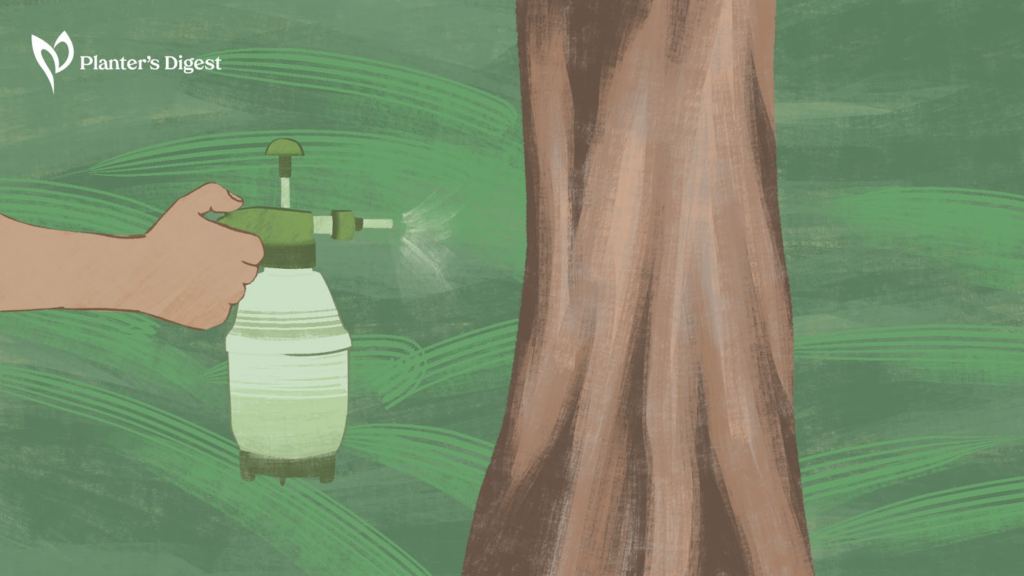
| Difficulty | Moderate ●●●○○ |
| Speed | Medium speed |
| Things You Need | • Personal protective equipment • Herbicide • Backpack sprayer or hand-held spray bottle |
This method involves spraying a herbicide solution directly onto the leaves and branches of smaller palm trees. Eventually, these trees die due to the absorbed herbicides.
| How to Kill a Palm Tree Through Foliar Spraying 1. Buy a herbicide sprayer and a herbicide solution. You might be tempted to buy just any herbicide, so don’t give in! Look for ones that contain triclopyr or picloram as these chemicals target and kill palm trees. 2. Put on your protective gear and equipment. Make sure you have gloves, goggles, and respirator masks to protect you from chemical spills and inhalation. Better to be safe than sorry! 3. Prepare the herbicide solution according to the instructions on the label. There’s no need for test the ratio when mixing your herbicide. We’re pretty sure the manufacturer’s got your back on that! 4. Once the solution is prepared, load it into the herbicide sprayer. You’re almost there! Be careful of accidental spills or drips when pouring the solution, though. 5. Get ready to start spraying. Adjust the nozzle to ensure that the spray is directed onto the leaves and branches of the tree. Spray and make sure all the leaves are covered, including the undersides. 6. Repeat after an hour to increase potency. Repeat after an hour or a few days to increase the strength of the herbicide. Actually, you can do it just once. However, we find that repeat applications have faster results. |
Important Notes
Foliar spraying is most effective when performed during the growing season. This is because the tree is actively transporting nutrients from the leaves to the rest of the plant.
Depending on the size and health of the tree, it may take several weeks or months for it to fully die. This is one of the most ideal methods for smaller palm trees.
8. Cutting the Tree Down
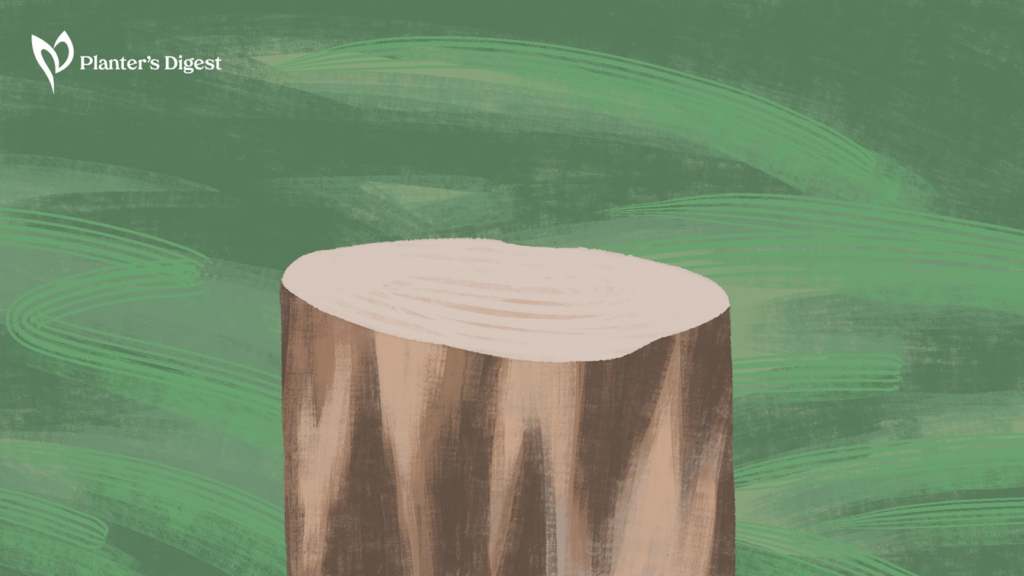
| Difficulty | Moderate ●●●○○ |
| Speed | Quick |
| Things You Need | • Personal protective equipment • Chainsaw • Felling wedges • Winch or other machinery |
Cutting down a tree is the best way to remove trees quickly especially if you’re in a hurry. Remember though that you need to plan it properly in order to execute it well.
When planning, you need to prepare everything you may need. Once everything is in place, expect better execution of your plans.
| How to Kill a Palm Tree by Cutting It Down 1. Mark the tree that needs cut down. You don’t have to do this if you only have one tree to eliminate. But if you have more than one, it really helps to mark them down for easy identification. 2. Look around for potential dangers. These include risks such as structures, power lines, or other trees that might be in the way. You want to avoid expenses caused by accidents, after all. 3. Make sure the tree falls in a safe direction. This is especially important if you have surrounding structures that may be affected by the fallen tree or trees. Ensure safety above all else! 4. Prepare the required tools and equipment. You will need chainsaws and felling wedges primarily. Prepare safety gear such as helmets, eye protection, ear protection, and cut-resistant gloves and boots. A winch or other machinery may be needed as well, depending on the size and location of the tree. 5. Make a horizontal cut, or a “notch” on the side of the tree. Keep in mind that the notch should be facing the desired direction of the fall. Ensure this cut is about one-third of the tree’s diameter. The cut should be made at a height that allows the feller to comfortably stand and make a second cut. 6. Next, make the second cut, called the “back cut”. It should be made on the opposite side of the tree. The location should be slightly above the first notch and at a downward angle. Ensure that this cut should leave enough uncut wood to act as a hinge, guiding the tree’s fall in the desired direction. 7. Monitor the fall of the palm tree. As the tree begins to fall, use the felling wedges to guide the tree’s fall in the desired direction and to prevent the tree from pinching the chainsaw blade. 8. Cut the trunk into smaller sections. Once the palm tree falls on the ground, cut its trunk into smaller manageable pieces. This will make it easier for you to move and transport. |
Important Notes
It is dangerous for you to cut down palm trees if you don’t know how. We suggest contacting professionals, even if it’s just to cut down a small palm tree.
How to Choose The Best Herbicide for Palm Trees

You can’t just buy any herbicide without thinking about some factors. Plus, you need to remember that herbicides are bad for our health.
Here are our suggestions to go about choosing the best herbicides:
1. Identify the type of palm tree.
Some herbicides only work for certain types of palm trees. Based on this, you must first identify the type of palm tree you want to get rid of before buying anything.
This will make things easier for you in the long run because you’ll end up making fewer mistakes.
2. Consider the size of the palm tree.
The size of the palm tree will determine the amount and strength of herbicide required to kill it. For small palm trees, a foliar spray may be enough.
Basal bark treatment or injection method is more suitable for larger palm trees. You’ll need to determine the size of your tree to arrive at the best treatment.
3. Evaluate the location of the palm tree.
Consider the location of the palm tree. Consider its nearness to other plants, structures, and water sources.
Some herbicides tend to impact other plants or animals in the area negatively. They can also be hazardous to people as well.
4. Determine the desired outcome.
Your desired outcome will determine your herbicide of choice. For example, if you want to remove the palm tree completely, you may use a herbicide that kills the roots.
On the other hand, some homeowners want to prevent the palm tree from growing back. In this case, you may opt for a growth regulator herbicide.
5. Research available chemical palm tree herbicides.
Once you have considered the mentioned factors, you’ll need to research the different chemical herbicides. We suggest looking at user experiences and product reviews.
You can even look for recommendations from experts in tree removal. This will help you a lot before you buy anything.
Just take time to research and it will help you arrive at better decisions. You will end up saving more time and effort in the long run.
6. Follow the instructions on the product.
Read the label and follow the instructions carefully. This is especially true when you’re working with toxic chemicals.
This will help you use herbicides safely and effectively. When you do this, you will minimize damages that affect people, animals, or the environment.
What’s the best way to kill a small palm tree?
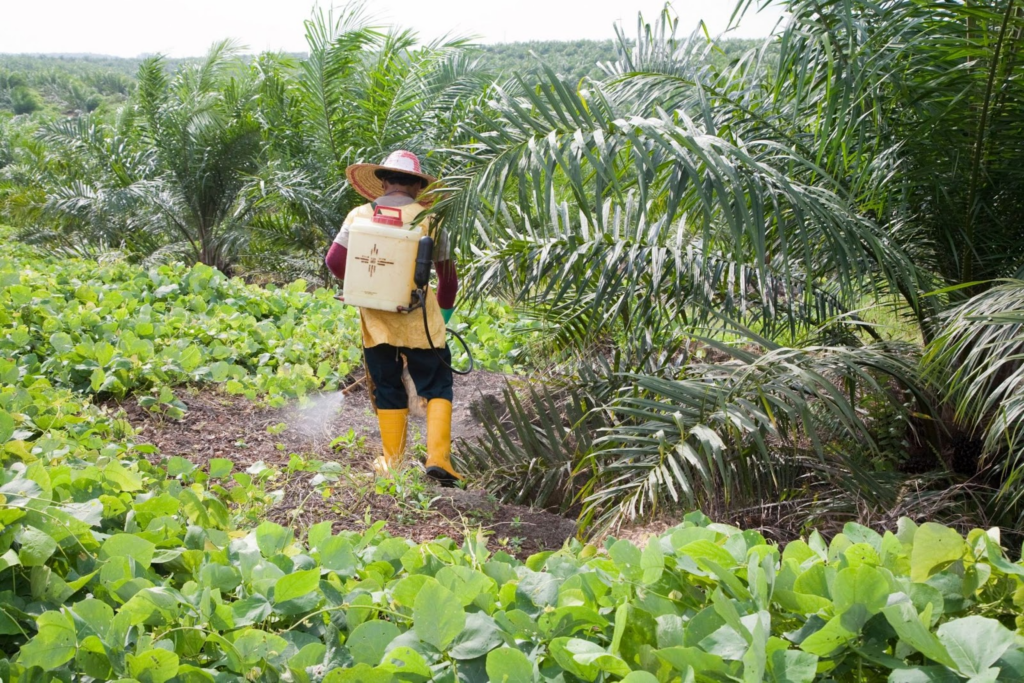
There are several good ways to kill a small palm tree, such as cutting it down, foliar spraying, and salting.
What’s the best way to kill a large palm tree?

The best ways to kill a large palm tree are injecting herbicides, basal bark treatment, girdling, or consulting a profesional.
How To Kill Palm Tree Roots

Killing the palm tree’s roots can be challenging. It’s even harder if the tree is still alive and growing.
Let’s look at two effective methods for killing palm tree roots:
1. Root Digging
This involves digging out the tree roots. To do this, you need to bring out your shovel or even just a plain axe.
Use the shovel or axe and dig around the tree. Just be careful when doing this because rough digging will also damage other plants.
Next, remove the roots once they all show up. You can now pull out the tree with the roots and put it aside.
Place the uprooted tree in an area where it will not disturb other people. You can also cut the tree into smaller pieces if you want.
Just remember that digging it out takes a lot of work. Also, this will require more than just one person to do it.
2. Herbicide Solution
Applying herbicides on the roots is another way to kill palm trees. Ideally, herbicides that are formulated to kill palm trees should be used.
Remember to follow the manufacturer’s instructions carefully. This will keep you safe from any danger.
Using herbicides will take several weeks or even months to fully kill the roots. This will not be ideal if you’re looking for a quick fix.
FAQs
Salt will definitely kill trees, including palms. This is because salt has a high concentration of natural compounds and ions that are very toxic to palm trees.
When it is absorbed, salt will cause root dehydration and nutrient imbalance. The palm tree will die as a result of not receiving water and nutrients.
Salting the palm tree can be harmful to the surrounding soil and other plants. Also, salt can also leach into the water system and cause damage to the surroundings.
Roundup will not kill most palm trees because they have a dense cluster of leaves that prevents the glyphosate in this herbicide from penetrating. Roundup has glyphosate as its active chemical, and this is why many palm trees are not affected by this herbicide.
You should be careful in using this herbicide though. Roundup can harm other plants and animals in the area since it is a non-selective herbicide.
While this herbicide brand can be effective for some, it is best to look for selective herbicides. Ideally, herbicides for woody palm trees should contain triclopyr or picloram to be effective.
If you’re looking to prevent invasive palm trees, use preemergent herbicides that contain trifluralin or oryzalin. To avoid any harm, follow the manufacturer’s instructions carefully.
Bleach has the potential to kill a palm tree. However, we do not recommend this for several reasons.
The first reason is that bleach can damage or even kill other plants in the area. Second, bleach is not a selective herbicide
It can harm both desirable and undesirable plants. From this, you can conclude that bleach is an ineffective and potentially harmful method for killing a palm tree.
Also, it may take a long time for bleach to kill the tree, making it an impractical choice. Overall, bleach may cause more harm than good.
If you need to remove a palm tree, we recommend using safer and more effective methods. These include cutting down the unwanted tree or using herbicides
Some species of palm trees are protected by law, just so you know. When you remove them without permission or permits, you may end up facing legal consequences.
We really suggest consulting with a professional landscaper for this. It’s also a good idea to consult with the local authorities if permits are required.
Many homeowners believe that copper nails can kill a palm tree. The idea behind it is that the copper nails will release copper ions into the tree and damage the tree.
Copper ions are usually toxic to trees and can eventually lead to their death. This is because high concentrations of copper are toxic to some trees.
However, studies still need to prove this theory. Most experts agree that is highly impossible that copper nails alone will kill a palm tree.
Their general consensus is that the amount of copper ions released by copper nails is usually not enough to cause damage to the tree.




